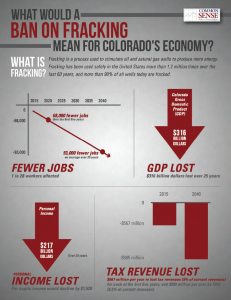
March 2014
Conducted by Richard Wobbekind and Brian Lewandowski from the Business Research Division of the Leeds School of Business at the University of Colorado Boulder.
In November 2012, voters in the City of Longmont passed a charter amendment effectively banning the use of hydraulic fracturing (fracking) and the storage of the resultant waste products by a 59.9% to 40.1% margin. The amendment does not ban drilling per se, but forbids the practice of fracking. This amendment set the stage for citizen initiatives elsewhere, including Boulder, Broomfield, Fort Collins, and Lafayette, that successfully passed moratoriums in November 2013. While legal contests to these bans and moratoriums are currently taking place, it is expected that another anti-fracking measure could be headed to the Colorado ballots this November. These measures fall into two general categories: local control and setbacks. Local Control Colorado has submitted language to the Colorado Legislative Services for a constitutional amendment that would allow Colorado voters a voice over whether hydraulic fracturing should be allowed within the bounds of their communities. Separately, the setback initiatives range between 1,500 feet and one-half mile. Colorado Governor John Hickenlooper describes the state’s regulation as “the most comprehensive and stringent” in the country. This study focuses on the economic impacts of a statewide ban on fracking.
Reporting the industry size in terms of gross domestic product, oil and gas extraction and support activities was nearly equivalent to the construction industry or the accommodations and food services industry in 2011. More than 87% of oil and gas activity in Colorado is concentrated in 5 counties, and 31 counties represent the remaining 13% of activity. However, the employment and tax impacts are much more widespread. The five largest-producing counties represent 35% of upstream and midstream employment, the 31 smallest-producing counties represent 29%, and the 28 nonproducing counties account for 36%. Likewise, while industry taxes have the greatest impact on local government spending, the industry also pays taxes that flow to the Colorado general fund, which is then spent on everything from education to infrastructure in the state of Colorado.
This study was modeled beginning in 2015, assuming a 95% reduction in new activity and continued legacy production from existing wells. The study incorporates the steep depletion rates for oil and gas production observed in Colorado historical data going back to 1970. Given a fracking ban beginning in 2015, the economic consequence would be an average $8 billion in lower gross domestic product (GDP) and 68,000 fewer jobs in the first five years compared to the baseline scenario, and an average of $12 billion lower GDP and 93,000 fewer jobs between 2015 and 2040. The negative impact on disposable personal income places drag on the consumption-supported industries, such as retail and real estate, as well as on taxes. Extrapolating prior research on fiscal impacts of the industry, the depletion production would leave Colorado jurisdictions with an average direct revenue reduction of $567 million over the first five years, declining $985 million by 2040.
The economic impacts are presented as a change from baseline expectations. The fracking ban shifts Colorado’s employment base downward, by an average of 68,000 jobs over the first five years, and by an average of 93,000 jobs between 2015 and 2040 (See Figure 1). The legacy production from existing wells and modest new production absent of fracking will continue to support direct and indirect upstream, midstream, and downstream employment. The direct industry impacts fall squarely on the Mining Sector, as well as some Construction (e.g., pipeline construction); Professional, Scientific, and Technical Services (engineering, R&D); and Government (regulation). The impacts of fewer jobs and wages result in reduced household spending impacts that affect everything from Construction to Retail Trade…
Download the complete report in pdf format >>
Pdf file (1.2MB)

